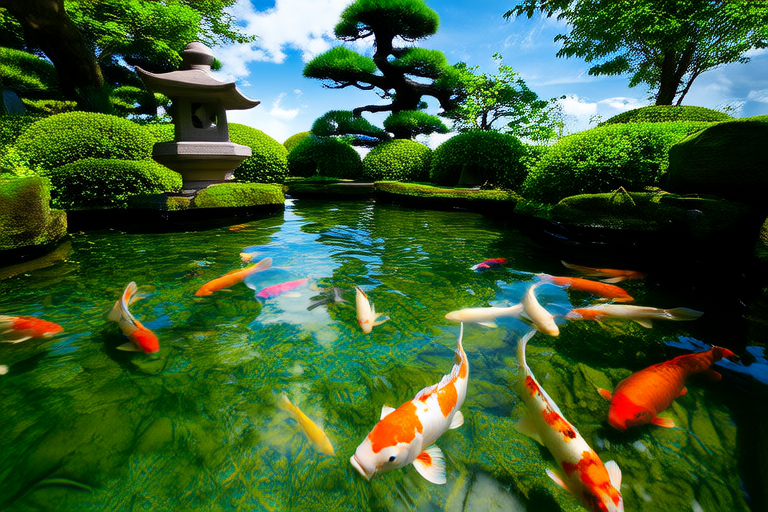How to Create an Oasis: The Ultimate Koi Pond Setup Checklist
Welcome to your comprehensive guide on how to create a serene oasis with your very own koi pond. Whether you’re a beginner or an experienced hobbyist, this checklist will ensure that your koi pond is not only functional but also a beautiful addition to your landscape.
Pond Location
Selecting the right location for your koi pond is crucial. It should be in a spot where it receives partial sunlight, ideally with morning sun and afternoon shade. This helps prevent excessive algae growth while still providing enough light for beneficial plants. Avoid areas prone to flooding or water runoff, as these can introduce contaminants into your pond. Consider proximity to power outlets for pumps and filters, and ensure easy access for maintenance.
Pond Size and Depth
The size of your koi pond depends on several factors, including the number of fish you plan to keep and local climate conditions. A general rule of thumb is to have at least 20 gallons of water per inch of adult koi. Depth plays a critical role in maintaining stable water temperatures; aim for a minimum depth of 3 feet to provide adequate thermal protection during winter months. Deeper ponds also offer more swimming space and better oxygen distribution.
Filtration Systems
A well-designed filtration system is essential for keeping your koi pond clean and healthy. There are three main types of filtration: mechanical, biological, and chemical. Mechanical filtration removes large debris like leaves and uneaten food from the water surface. Biological filtration supports beneficial bacteria that break down harmful ammonia and nitrites produced by fish waste. Chemical filtration uses media such as activated carbon to absorb dissolved organic compounds. Choose a combination filter that effectively addresses all aspects of water quality management.
Aeration
Proper aeration ensures sufficient oxygen levels in your koi pond, which is vital for the health and vitality of your fish. Surface agitation created by waterfalls or fountains can increase oxygen exchange between air and water. Additionally, installing an underwater aerator pump will help circulate water throughout the entire pond, promoting even distribution of oxygen and preventing stagnant areas. Regularly check your aeration equipment to ensure it operates efficiently, especially during warmer weather when oxygen demand increases.
Lighting
Incorporating appropriate lighting enhances both the visual appeal and nighttime ambiance of your koi pond. Submersible LED lights placed strategically along the bottom of the pond can highlight aquatic plants and create mesmerizing effects when viewed from above. Solar-powered fixtures offer eco-friendly alternatives without requiring additional wiring. For added security and safety, consider motion-sensor floodlights positioned around the perimeter of the pond area.
Plant Selection
Selecting the right plants not only adds aesthetic value but also serves important ecological functions within your koi pond ecosystem. Floating plants like water lettuce and hyacinths help reduce sunlight penetration, thus inhibiting algae growth. Emergent species such as cattails and pickerelweed provide hiding spots for young fry and contribute to nutrient cycling. Marginal plants like iris and bog lilies soften edges and add color. Always choose native varieties whenever possible to support local wildlife and maintain biodiversity.
Koi Feeding Tips
Feeding your koi properly promotes their growth and longevity while minimizing waste production. High-quality commercial pellets formulated specifically for koi offer balanced nutrition containing proteins, fats, carbohydrates, vitamins, and minerals necessary for optimal health. Feed small amounts frequently rather than large quantities less often to encourage natural feeding behaviors and prevent overfeeding. Adjust feeding rates according to temperature changes – reduce feedings during colder periods when metabolism slows down.
Maintenance Schedule
Regular maintenance keeps your koi pond running smoothly and extends the lifespan of its components. Establish a routine that includes weekly checks of water parameters (pH, ammonia, nitrite, nitrate), cleaning filters, trimming excess vegetation, and removing debris accumulation. Seasonal tasks may involve deep cleaning the pond bottom, inspecting electrical connections, and ensuring proper operation of heating devices if used. Stay proactive about addressing potential issues before they escalate into bigger problems.
Cost Breakdown
Setting up a koi pond involves various expenses ranging from initial construction costs to ongoing operational expenditures. Initial investment typically covers excavation, liner installation, plumbing materials, filtration units, pumps, lighting fixtures, and decorative elements. Operational costs include electricity bills for running pumps and heaters, replacement parts for worn-out components, specialized foods for feeding koi, and periodic treatments for controlling algae blooms. Factor in long-term savings achieved through DIY projects versus professional installations to optimize budget allocation.
Creating an oasis with your koi pond requires careful planning and attention to detail. By following this ultimate setup checklist, you’ll be well on your way to enjoying a thriving aquatic environment filled with vibrant colors and soothing sounds. Remember to embrace creativity and adaptability throughout the process, allowing your unique vision to shape the final outcome.
